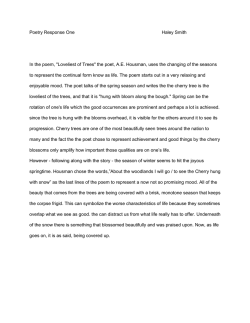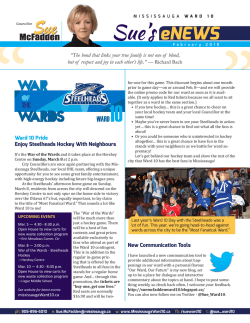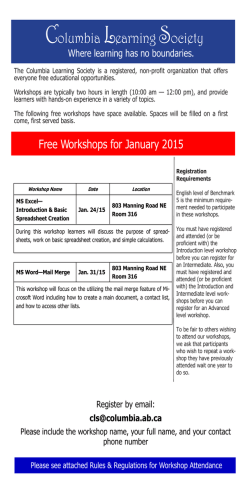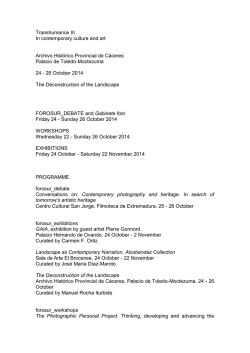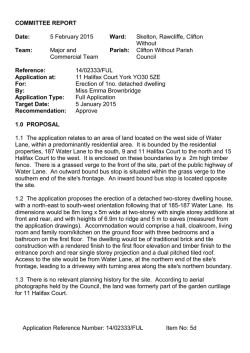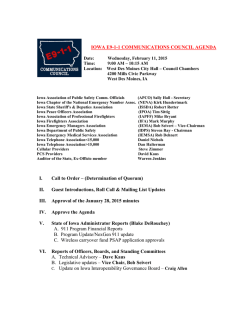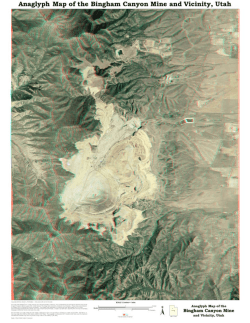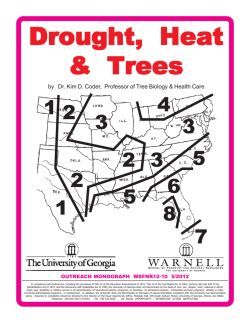
Workshop Descriptions - Iowa State University Extension and
GENERAL SESSIONS and WORKSHOPS He will review how to use the concepts of normality and patterns in which plant disorders express themselves…to focus in on signs and symptoms that will ultimately lead to a proper diagnosis. Most importantly, Cliff will discuss how you can use site history information when standard diagnostic practices have led you to a dead end. Finally, Cliff will demonstrate how you can use over 1000 images in the Purdue Tree Doctor smartphone app to make a quick and accurate diagnosis and obtain research-based management recommendations. OPENING GENERAL SESSION Wednesday, February 25, 2015 - 9:30 a.m. State of the Green Industry Well folks, we finally wore him down! After pestering him for years, we finally succeeded in luring Dr. Charles Hall to Iowa to serve as one of our keynote presenters for the 2015 STSC. According to Charlie, tree growers and landscapers were among the hardest hit sectors of the green industry during the Great Recession. BUT, there is evidence of marked improvement in the green industry marketplace from now until the next recession (projected in 2018), however, there still are significant hurdles to overcome. In this session, Charlie will provide a near-term economic forecast for the industry and highlight what that means for growers and landscape and tree care service providers. Be prepared to leave this session with plans for tweaking your strategic plans for the upcoming season. Don’t Just Plant More Trees…Plant Better Trees! Adopted Iowan and one of our all-time favorite presenters, Dr. John Ball is back with us in 2015, this time to talk about planting “better” trees. Young trees at the garden center are like puppies and kittens…they all look cute and perfect and you can’t wait to bring them home. But just like our furry friends who sometimes turn into something unexpected and unpleasant, unwanted surprises await if you bring home the wrong tree. As emerald ash borer spreads and begins causing widespread ash mortality, increased attention will be paid to replacing thousands of trees. Of course, this action is commendable, but plant material choices made without concern for adaptability, longevity, long-term structural integrity, and/or invasive nuisance potential will always come back to soil the carpet…as it were. CLOSING GENERAL SESSION Thursday, February 26, 2015 - 2:30 p.m. Using Your Brain and Smartphone to Diagnose Tree Problems This is going to be fun! In this closing general session, Dr. Cliff Sadof will demonstrate how to systematically diagnose common tree disorders using symptoms, patterns, and signs. Session A Workshops A-1. (E-1 Repeat) Overview of Giant Tree Transplantation Methods Paul Cox, Environmental Design, Inc. Tomball, TX Would you like to know how to successfully move a bur oak tree that was alive at the time of the American Revolution? Then you’ve come to the right place. In this workshop Paul Cox, Regional Vice President at Environmental Design, Inc. will describe the creative and complex process used to relocate this historic tree on the campus of the University of Michigan (Ann Arbor). A-2. The True Value of Trees Charlie Hall, Texas A&M University College Station, TX In the future, the value proposition for the green industry must focus on the unique ways in which quality of life is improved for its customer base. And across all generations (Boomers, Gen Xer’s, Gen Yer’s, etc.), quality of life is a “higher order” need important to everyone. Research shows that there’s no better way to do this than through the daily use/enjoyment of trees and other plants. Now, all the green industry has to do is convince consumers that their products and services are necessities instead of luxuries. In this session, Charlie will explain just exactly what we need to do to pull this off! A-3. Tree Worker Incidents: The Who, What, How, and Why John Ball, South Dakota State University Brookings, SD Tree worker incidents don’t just happen, they occur because of factors that aligned before the incident. And the severity of worker injuries often depends on what happens during the incident…and afterwards. In this session John will cover how the most common tree worker incidents occur and show what you can do to not become next year’s statistic! *Qualifying Pesticide Applicator Workshops **Required Pesticide Applicator Workshop 3 WORKSHOPS A-4. Evolution and Introduction of Hardscapes into American Landscapes Paddy Conway, Cotswold Gardens, Ltd. Palos Hills, IL from hylophobia (the fear of forests) to biophilia (the love of living things). The human connection to nature and to trees specifically can incite community support for the planning, planting, and management of trees in the landscapes we inhabit and explore. From time-tested workmanship in Europe to the American landscapes, Paddy will discuss the evolution of the hardscape industry in America. He will stress the importance of quality products, quality installation, workmanship, and customer service to help you grow your business and be more successful. Session B Workshops A-5. (D-3 Repeat) Diagnosing Health Problems of Woody Plants* (2 hours) – Limit 30 per session Laura Jesse, Iowa State University Ames, IA Mark Vitosh, Iowa DNR District Forester Iowa City, IA As perennial as crabapple flowers in the spring and timeless as food poisoning when dining with Mark Vitosh on the road, this workshop continues to rank as one of the most popular offerings in STSC history. And this year’s edition will offer the usual laughter, tears, and learning opportunities… and then some! There’s even rumor of a special guest presenter. As always, sign up early if you want a seat at the table. A-6. Smart Garden Design – Case Study Limit 50 Greg Pierceall, Purdue University West Lafayette, IN Greg is back by popular demand, and for those of you who’ve heard him speak before, well, you probably should just plan on spending the entire morning with him. In this first workshop session he will introduce you to the Smart Garden at the Chicago Museum of Science & Industry…a landscape of production, vegetables, and prairie for residential utility. The case study presentation will trace the site and landscape design from start to completion. A-7. (E-7 Repeat) From Phobia to Philia – Our Fear and Love of Forests and Trees Julie Stevens, Iowa State University Ames, IA Early settlers feared the forests of the New World, but today we plant, celebrate, preserve, and protect forests and trees. This session will explore the relationship between trees and people *Qualifying Pesticide Applicator Workshops **Required Pesticide Applicator Workshop 4 B-1. (C-1 Repeat) Shade Trees by Default Mike Score, Hantz Farms Detroit, MI Hantz Farms is using commercial forestry as a tool for transforming blighted neighborhoods on Detroit’s lower eastside. In this workshop, Mike will discuss the process that was required to launch this venture, review the steps taken to establish a commercial woodlot, and consider the impact of this investment on neighborhood quality of life. B-2. (C-4 Repeat) Nursery Stock – Are You Getting What You Pay For? Jim Flott, Community Forestry Consultants, Inc. Spokane, WA One role that park managers and staff are asked to fill is that of purchaser and inspector of nursery stock and landscape trees. Many green industry professionals across the country tell me they are unable to find quality trees for planting projects. They say many nursery stock specifications lack the necessary detail to ensure good stock gets purchased and installed. Buying high quality nursery stock is all about writing explicit nursery stock specifications. In this interactive hand’s-on presentation, Jim will provide superior nursery stock specifications and give you an opportunity to write your own. B-3. (E-5 Repeat) Protecting Ash Trees in Your Communities from Emerald Ash Borer* Cliff Sadof, Purdue University West Lafayette, IN In this workshop Cliff will share research based information on how insecticides can be effectively applied to protect ash trees from the emerald ash borer. His discussion will include a review of all insecticides labeled for EAB control and description of how long each will last after application to the tree. Cliff then will show how his web-based cost calculator can be used to demonstrate why it makes economic sense to protect rather than replace trees as they die. Finally, he will address environmental concerns and the potential use of biological control in the natural forest. WORKSHOPS Session C Workshops C-1. Shade Trees by Default (See description B-1) C-2. (D-2 Repeat) Identifying, Understanding, and Developing Ash Resistance to EAB* David Showalter, Ohio State University Columbus, OH B-4. (E-6 Repeat) Pollinators and Beneficial Insects and Landscape Management* Vera Krischik, University of Minnesota St. Paul, MN Pollinators are in decline due to multiple factors: habitat loss, poor quality food, parasites, and insecticides. In fact, neonicotinoid systemic insecticides affect foraging behavior and colony health at levels of residue found in landscape plants. In this session Vera will describe how landscape management practices can be modified to prevent pollinator loss. B-6. Quick Landscape Design Techniques (2 hours) – Limit 50 Greg Pierceall, Purdue University West Lafayette, IN Landscape design is a service and a product. Understanding the basic components of site and landscape design helps clarify the “basics” in design. In this workshop Greg will demonstrate quick and basic landscape site design. Sign up for this workshop and experience the clean landscape design process. B-7. (F-1 Repeat) Tree Cultivars of Starhill Forest Arboretum Guy Sternberg, Starhill Forest Arboretum Petersburg, IL In this workshop David will cover the scope of the emerald ash borer problem and the threat to the North American ash resource. He also will provide updates on “lingering ash”– native ash trees that have survived longer than others in heavily infested areas, and discuss recent findings pertaining to resistant Asian ash species. Ongoing and future work to breed and propagate EAB-resistant North American ash also will be covered. C-3. Plant Collecting in the 21st Century – Is it Still Important? Michael Dosmann, Arnold Arboretum Boston, MA Ah yes, the old Victorian pastime of plant collecting. Is this activity even relevant in the 21st century, or is it just a boondoggle? Sign up for this session and learn a tiny bit about the history or plant exploration, but in the context of modern-day goals for horticulture and basic botanical knowledge. By the way, welcome back to Iowa State Dr. Dosmann! C-4. Nursery Stock – Are You Getting What You Pay For? (See description B-2) C-5. Hardscape Pricing & Presentation for Profit Paddy Conway, Cotswold Gardens, Ltd. Palos Hills, IL Paddy is back for his second presentation of the day, and this time he’ll be discussing how to price jobs, estimate costs, sell to consumers, and market your company to ensure you make money and build your company to succeed and last. From its early beginnings in the 1960’s until the present, many very special trees have been found in the Starhill Forest Arboretum propagation beds or during collecting trips around the world. And some of them were just too unique or interesting not to introduce into general cultivation…so, here we go! Come and see the trees and learn their fascinating stories. 5 WORKSHOPS C-7 (G-7 Repeat) Continuing Instructional Course for Pesticide Applicators** Limit 50 per session Mark Shour, Iowa State University, Ames, Iowa This workshop is required if you want two hours of approved instructional training credit toward pesticide applicator recertification at the 2015 STSC. The Iowa Department of Agriculture and Land Stewardship has approved the ISU Shade Tree Short Course for continuing instructional credit in categories 2, 3O, 3OT, and 10. Specific information will be presented on equipment calibration, safe application techniques (including drift), pesticide stewardship, and pesticide labels. You also must attend one additional qualifying workshop (A-5, B-3, B-4, C-2, D-2, D-3, E-5, or E-6) to receive certification. NOTE: Pesticide applicators wishing to recertify will be charged an additional $35 (see registration form). Session D Workshops D-1. A Tale of Twenty Trees Michael Dosmann, Arnold Arboretum Boston, MA Every plant has a story or two to tell. Sign up for this session and listen to a few short stories about twenty charismatic trees from one our finest arboriculture story-tellers. You’ll learn who may have discovered one species, or why another is perfect for your landscape. And lastly, you’ll come away with a greater appreciation for tree story telling – and writing. D-2. Identifying, Understanding, and Developing Ash Resistance to EAB* (See description C-2) D-3. Diagnosing Health Problems of Woody Plants* (See description A-5) D-4. A Prescription for Health: Designing Gardens for Healing Bruce Zaretsky, Zaretsky & Associates Rochester, NY It has been said that laughter is the best medicine. Well, they’re wrong…gardens are the best medicine! Why? Gardens are beautiful. They are pleasant to look at and be in. They make us feel better. But did you know they can actually reduce stress and help people physically heal faster? Sign up for this workshop and join Bruce on an exploration of gardens as healing devices, and learn how to incorporate aspects of healing gardens into every garden you design and care for. D-5. (F-3 Repeat) Grafted Conifers for the Midwest Market Mark Van Hoef, Oregon Pride Nurseries, Inc. McMinnville, OR With 40 years in the nursery business, Mark certainly knows what he’s talking about, and in this session he will describe why unique garden conifers are important additions to the retail nursery/landscape mix. He also will describe how these plants are produced and grown and describe the “top 20” grafted conifers for our region. D-6. (G-5 Repeat) Starting From the Roots Up Mike Bevins, Iowa Department of Agriculture and Land Stewardship Des Moines, IA Mike knows how to grow a quality tree, and in this session, he’s willing to share his trade secrets. Sign up for this workshop and gain some insight into what it takes to start and operate a small-scale, grown-from-seed, native tree and shrub nursery. Mike prefers the Rootmaker® brand of containers and will discuss the theory behind these root pruning products and the benefits of an enhanced root system. D-7. (F-7 Repeat) Alive and Kicking: Maintaining Bedding Plants in the Retail Environment Chris Currey, Iowa State University Ames, IA Each spring, garden centers fill with colorful annuals and herbaceous perennials…all ready to be sold. However, these plants can decline as they sit on shelves. Would you like to minimize the number of plants that get tossed out back to the compost pile? If so, come along with Chris as he describes ways to keep herbaceous bedding plants looking good throughout the spring retail season. Session E Workshops E-1. Overview of Giant Tree Transplantation Methods (See description A-1) *Qualifying Pesticide Applicator Workshops **Required Pesticide Applicator Workshop 6 WORKSHOPS Session F Workshops F-1. Tree Cultivars of Starhill Forest Arboretum (See description B-7) F-2. At the Root – Moving Large Trees Economically (See description E-2) E-2. (F-2 Repeat) At the Root – Moving Large Trees Economically Jim Flott, Community Forestry Consultants, Inc. Spokane, WA Bare root transplanting has been used since humans started walking the earth. It is “the root” of the nursery industry. The modern demand for immediate effect in the landscape or retention of existing landscape trees can be met by successful bare root transplanting of large DBH trees…and it can be done economically. In this presentation, Jim will review the process of moving large diameter trees bare root that will provide you with an avenue of revenue for your business. E-4. How Green Are You? Sustainability in the “Green” Industry Bruce Zaretsky, Zaretsky & Associates Rochester, NY The landscape industry is the real “green industry”. Or is it? As landscape professionals we should have green growing through our veins, but in the name of landscape design and installation, are we doing more harm than good? In this presentation Bruce will identify places where we excel, where we fail, and where we can be better…from proper plant choices, to sourcing materials, to water conservation, and more. Let’s strive to be “greener” for our clients, our companies, and for our planet. E-5. Protecting Ash Trees in Your Communities from Emerald Ash Borer* (See description B-3) E-6. Pollinators and Beneficial Insects and Landscape Management* (See description B-4) E-7. From Phobia to Philia – Our Fear and Love of Forests and Trees (See description A-7) F-3. Grafted Conifers for the Midwest Market (See description D-5) F-4. (G-4 Repeat) Champion Trees Doug Grimm, Grimm’s Retail Garden Center Hiawatha, KS Long-time STSC participant, and now first time presenter, Doug will describe state and national Champion Trees and how to grow them. This is one of Doug’s passions and in this presentation, he will share the colorful history behind many of these giant and historic trees. F-5. (G-1 Repeat) Dormant Wood Grafting Limit 30 per session Michael Yanny, JN Plant Selections Menomonee Falls, WI In this workshop Mike will demonstrate various grafting techniques (whip and tongue grafts, cleft grafts, side veneer grafts, top-working, and piece-root grafting) that can be used at this time of year to successfully propagate woody plants. He will explain why some techniques are more favored than others, explain some of the common mistakes made by inexperienced grafters, and talk about his experiences as a grafter over the past 35 years. And of course, an original plant poem will be thrown in just to get the brain spinning! F-6. (G-6 Repeat) Introduction to LED Lighting John Wurst, J & J Midwest Sales St. Louis, MO The use of LED lighting in the landscape has gained widespread acceptance and in this workshop, John will cover all aspects of LED lighting including electrical savings, color temperature of the light (Kelvin), warranty vs. life expectancy, and using integrated LED fixtures vs. LED drop-in-lamps. John also will touch on some installation advantages of LED and reduction in voltage drop due to lower wattages being used. 7 WORKSHOPS F-7. Alive and Kicking: Maintaining Bedding Plants in the Retail Environment (See description D-7) Session G Workshops G-1. Dormant Wood Grafting (See description F-5) G-2. Understanding Oak Hybridization Guy Sternberg, Starhill Forest Arboretum Petersburg, IL The hundreds of species of oaks divide along several lines into interfertile breeding groups, further complicated by anemophilous (wind) pollination and protandry (the condition that prevents self-fertilization). In this workshop Guy will explain the mechanisms, potential, and limitations of oak hybridization in understandable terms and introduce some promising hybrid oak cultivars. G-3. Winter Tree Identification Mark Vitosh, Iowa DNR District Forester Iowa City, IA Accurate tree identification is critically important for making correct tree management decisions, even during the winter months. In this session, Mark will introduce participants to key tree characteristics (bark, buds, leaf scars, etc.) used in identifying trees in the winter using examples of common landscape trees found in the upper Midwest. Rumor has it Mark can identify a tree blindfolded, using only his keen sense of smell. Perhaps he’ll demonstrate this extraordinary skill for his enthusiastic audience. G-4. Champion Trees (See description F-4) G-5. Starting From the Roots Up (See description D-6) G-6. Introduction to LED Lighting (See description F-6) *Qualifying Pesticide Applicator Workshops **Required Pesticide Applicator Workshop 8 G-7. Continuing Instructional Course for Pesticide Applicators** (See description C-7) PESTICIDE CONTINUING EDUCATION The Iowa Pesticide Act provides two options for renewing commercial pesticide applicator certification. Commercial and public applicators may choose to renew their certification by testing once every three years or by attending approved instructional training each year. Recertification by training requires participation in two hours of approved instructional training each year, in each category in which an applicator is certified. Some programs may be approved for more than one category and simultaneous credit hours are possible. Applicators will not be allowed to make up hours that they missed in a previous year, nor will they be allowed to carry forward excess credit hours. The Iowa Department of Agriculture and Land Stewardship approved the ISU Shade Tree Short Course/INLA Conference and Trade Show for two hours of recertification credit in categories 2, 3O, 3OT, and 10. To receive recertification credit, an applicator must attend workshop C-7 or G-7, “Continuing Instructional Course for Pesticide Applicators,” and any one of the following workshops: “Pest Management” Workshops: A-5 or D-3 Diagnosing Health Problems of Woody Plants (Jesse and Vitosh) B-3 or E-5 Protecting Ash Trees in Your Communities from Emerald Ash Borer (Sadof) B-4 or E-6 Pollinators and Beneficial Insects and Landscape Management (Krischik) C-2 or D-2 Identifying, Understanding, and Developing Ash Resistance to EAB (Showalter)
© Copyright 2025
